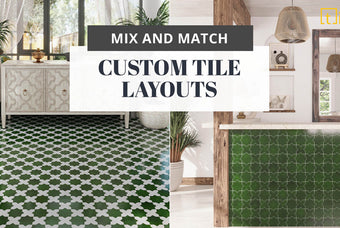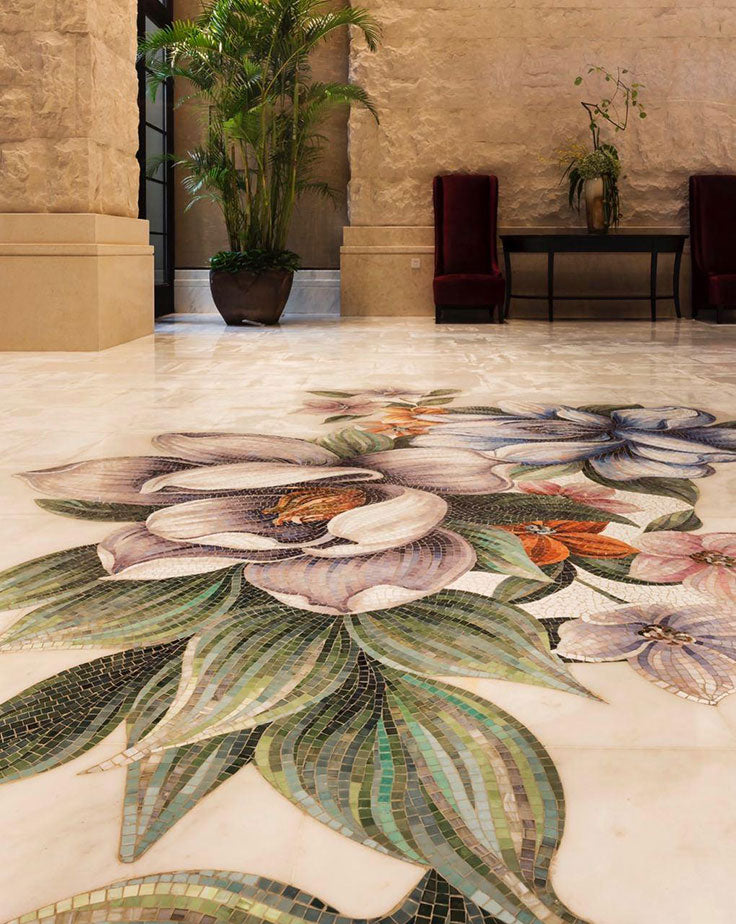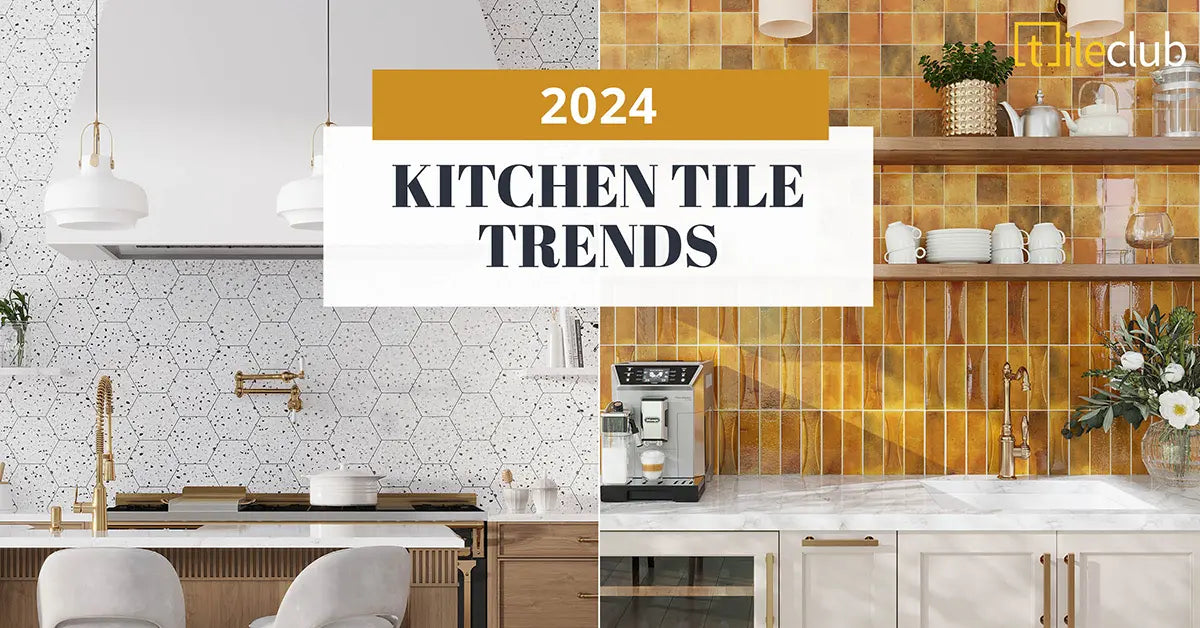A tile rug? That’s right — exactly as the name implies, it’s a rug made of tile! Skip vacuuming the carpet when you can bedazzle your space with a floor tile accent that’s almost too beautiful to walk over — almost.
For a striking statement, this glorious Crema Marfil tile offers a timeless arabesque pattern and Bardiglio dots. Complement this tile rug with a neutral accent wall to create visual balance with the decorative floor tile. Also, consider a freestanding tub for that extra special indulgence!
Conventionally, the tile rug was the go-to for commercial spaces like office buildings and shopping malls, but now they’re finding their way into our homes! So, not only are we giving kudos to whichever genius started this trend, we’re also rolling out some clever tile rug ideas to personalize your home or even add a unique branding detail to your business! Let’s get started...
Vintage glam

New York-based designer, Ariella Horowitz, shows us how to put a modern spin on a classic tile rug. Its black-and-white floral pattern offers a stunning tile rug idea, which works to complement the surrounding white marble floor tiles. This beautiful entryway flooring design is a stunning way to welcome guests to her home!
Create a similar design with the Thassos Leaf Mosaic tile, featuring a charming kaleidoscope pattern. This design combines the white hues of Thassos marble and different shades of Athens Gray and Crystal Sand, creating a chic fusion of natural stone tones for a magazine-worthy impact.
Pro-Tip - similar to its wall decor cousin, the backsplash insert or medallion, the key to creating a successful tile rug is adding a border. Our recommendation! Stick with the same material for your tile trim and choose a contrasting color to create a dramatic outline of your rug pattern. In this case, a black marble tile molding creates a strong distinction between the marble mosaic rug design and the white marble field tiles of the rest of the floor!
Elevate Classic Bathroom Design with a tile rug
You can’t argue with tradition! Elegant and inviting, these ornate tiles bring a cozy yet upscale feel to your bathroom. We love adding a patterned tile inset to a traditional bathrooms design to add a unique design element while still keeping the rest of the look timeless.
The Babylon Star Marble tile is embossed with floral etchings — an elaborate detail that adds complexity and sophistication to the tile rug. What’s more, its anti-slip qualities are ideal for the bathroom floor! Not only is it practical, but it doesn’t absorb water so it’s easy to maintain.
Or if you prefer a monochrome color scheme, consider this Basket Weave tile. This classic pattern makes a beautiful tile rug for any contemporary bathroom design! The design picks up the natural stone of the Carrara marble bathroom floor tiles while the Eastern Black marble tile squares create a subtle pattern that doesn’t overwhelm from the rest of the neutral bathroom decor!
Art Deco
Inspired by the opulent lifestyle of the 1920’s, these art deco glass tile rug patterns offer brilliant ways to decorate your powder room or Master Bath! It’s a clever way to bring a ritzy quality to your floor without looking pretentious.
For your kitchen, the Diamond Carrara tile combines silver shape contours over white Italian marble. You can even use these deco tiles along the wall or backsplash to create a harmonizing effect!
What about creating a dynamic entranceway? This Roman Circles Carrara White Waterjet Mosaic With Silver Lines insert features silver circles for a touch of refinement. With its dramatic color palette, this design brings vibrant hues to your tile rug. We love seeing it on an accent strip along the wall to create a unified design!
Contemporary tile rug
Turn your bathroom floor into a grand stage!

Selby Davis also showcases a contemporary theme with a tile rug that leads toward the tub. Neat right? If you like this idea, you can create it with the Thassos and Carrara Weave tile. The white octagons and grey stone shapes form a lively pattern that breathes passion into your space. The neutral tones pair beautifully with the natural wood cabinets and door frames, while creating a beautiful lead in to the cozy soaking tub.
Create a custom floor mural
Sometimes we crave the goods that are not on the menu. Fortunately, if you work with our team on a custom mosaic tile floor mural, your decor chef can cook up any design!
These homes, for example, feature grand floral murals in the foyer. It’s a personalized touch that gives your guests that wow-factor immediately when they enter your home. These nature themes are always classic, or you can decorate with something bolder like an optical illusion or abstract art!

A custom floor rug mosaic mural is also a stunning way to brand a business! Turn your restaurant or shop name into a shareable moment with a charming tile rug that reflects your logo and brand colors, like this ‘feet selfie’ picture shared by Tyler Elise! Adding a visually appealing branding detail is key to creating word of mouth - and word of ‘gram!
Retro vibes
No matter the decade, geometry is always in style! This tile rug idea puts some retro flair into your entryway or bathroom floor.
This Circles Micro Mosaic Tile blends white and gray natural stone together to make a circular pattern that’s fresh and organic. The swirling design is perfect for a soothing environment, and we love how this design continues it up into the wall for a vertical tile inlay!
Lettered tile rug

Can you spell, “awesome”? This custom lettering concept invites warm, friendly vibes to your home. Known as tile typography, it’s an inspiring way to greet guests in the doorway.
This design is usually done in penny tile — an inexpensive option that looks adorable! Before installing, be sure to take accurate measurements and mark the lettering pattern. Due to the complexity of this project, you should hire a professional contractor to do the job, or check out how Fontaine Farmhouse created this retro rustic bathroom with a step-by-step tile pattern to DIY this fun personalized floor!
Mid-century modern


The bold impact of a graphic pattern never fails to impress. Lindye Galloway shows us her creative handiwork with a triangle print tile rug that seamlessly transitions into her floor without adding any borders.
You can create a similar concept with the Sand Valley and Thassos tile. This distinctive pattern brings a unique focal point to a contemporary bathroom design. Compliment this monochrome theme with a white marble vanity top and walls, along with natural wood cabinets for an earthy design! A lush green plant and a wooden mirror frame can infuse some natural energy into the space.
Design Rules for Creating a tile rug
Although your tile rug is a personal touch, there are a few dos and don'ts you should learn to master this art. Overall, the goal is to unite different tile patterns together, while staying true to one cohesive design concept.
Size to scale
The wrong tile rug size can leave your rooms feeling slightly askew. To keep dimensions to scale, you should consider two key factors: the type of room and the scope of the floor.
For a small entranceway, the tile rug should be the same size as a standard welcome mat (about two by three feet, or slightly bigger. But if you’ve got a grand foyer, you should cover a large expanse of the floor. How much? The general rule is to allow at least 18”-24” of floor space between the wall and the border of the tile rug.
If the location is your bathroom, the tile rug should be placed in the center of the floor without overlap from the vanity or tub. Leave at least a square foot of the base tile between the wall and the tile rug to avoid your decorative floor pattern making your bathroom feel crowded.
Design principles for a tile rug

To create an appealing result, you must consider the “rules” of design. Since you’re combining multiple elements (values, shapes, colors), you’ll want to ensure they come together in an attractive way.
Let’s review some guidelines to help you get the best result.
Blend or contrast
Tile rugs can either blend or contrast with the main floor tile. If you choose to blend, it means the main floor tile will belong to the same color or tonal family as the tile rug. Or if you contrast, it means the tile rug will pop against the main floor tile (like black against white). Both options have their own appeal — the one you choose depends on your personal taste.
If you prefer a classic look, choose a neutral style for the base tile, like Thassos or Calacatta Gold marble, and select a pattern with matching hues like earth tones or greys for the decorative tile detail. The key is keeping the color scheme consistent to create harmony! If you take a more playful approach to color, following these guidelines may be a bit trickier.
Color coordination
What if your style is funky? No problem! Just pay extra attention to your color coordination.

This contemporary black and white bathroom combines a Diamond Marble tile with a darker border to enhance the design. You can even build on this black-and-white theme with matching elements in your bathroom. For example, a black-painted tub creates a grounding effect, while a black ceiling balances the entire space.
You can contrast the base tile with a more striking tile design, like a blue vintage mosaic or multicolored hexagons. But even if you’re working with opposition colors, there should still be some level of coordination — otherwise, the tile rug may appear awkward or misplaced. For example, let’s say you’re making a statement rug with green and grey hexagon tiles in your bathroom. The surrounding tiles should be a solid one solid color such as white or cream with grey veining to match the lighter tones in the tile rug.
Basically, the rule is that even if the tile rug is an accent, there should still be color harmony.
Create a focal point
Too many colors and shapes on the floor look chaotic. So when combining many colors, it’s important to be creative without looking like you’ve got design ADD.

Design firm Sheedy De La Rosa followed that brief when creating the bathrooms for the Long Bay Villas Anguilla! The sand tones in the field tile flooring are picked up in the lines of this basket weave floor tile, with white marble squares to add contrast and tie in the open air outdoor shower!
When designing a tile rug, it should stand as the main focal point of the room. For this reason, the surrounding base tiles should be a solid color with only subtle veining. You may even want to downplay other decorative elements in the room, so they don’t compete for attention with the tile rug.
Do tile rugs need a border?
Borders are an option — not a requirement. However, if you like the idea of encasing your tile rug with a border, that’s your choice!

This beauty by the Wolf Design Group picked up the darker notes in the decorative mosaic tile floor inlay in a black marble border trim to turn the tile rug into a focal point in this Atlanta home.
In many cases, a tile rug looks more aesthetically pleasing with a border. By placing a darker tile color around the edges of the rug, it becomes separated from the surrounding tiles. The benefit is that the tile rug stands out more and appears intentional.
Although a border isn’t always necessary, there’s one scenario where it’s a must. When the tones in the tile rug are almost identical to the ones in the surrounding tiles, then you absolutely need a border. Otherwise, you’ll have two different tile designs that fuse together in a visually confusing way.
These design rules can help create a tiled rug inlay that gives your interior a stunning upgrade - but you also have a lot of room to play! No matter what, the goal is to create a beautiful visual - whether you use it to welcome guests, create a luxurious environment, or seize an opportunity for a branding moment!

Ready to plan some tile rug ideas? Flip your floor from “meh” to marvelous with any of these design inspirations.






















0 comments. Write a comment